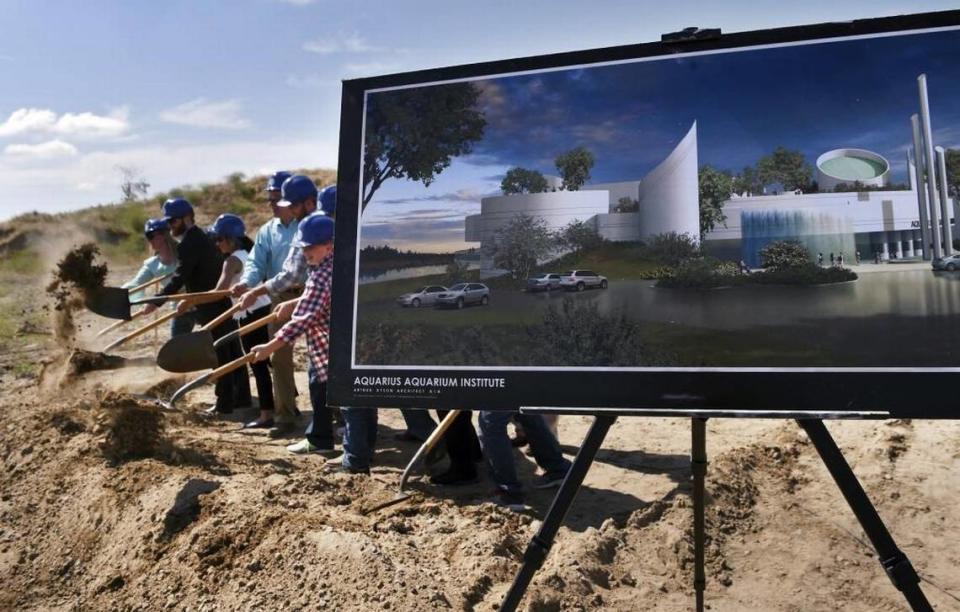The Fresno Aquarium has been planned for two decades. But is it ever going to happen?
Reality Check is a Fresno Bee series holding those in power to account and shining a light on their decisions. Have a tip? Email tips@fresnobee.com.
There’s a joke that Tom Lang has heard more than a few times over the years about which is more likely to get built first, the Fresno Aquarium or California’s High Speed Rail.
Lang is on team aquarium.
“I think we’re going to beat it,” says Lang, executive director of the Aquarius Aquarium Institute, the volunteer nonprofit that’s been working on the Fresno Aquarium project for two decades.
The question is how?
Lang, along with his wife Aletha, began making the pitch for the Fresno Aquarium in the early 2000s. At the time, the project —with a design by Fresno architect Arthur Dyson— was expected to cost $15 million and break ground within a few years on a 10-acre plot of land that had been deeded to the cause by JFJ Farms.
That land, just off Herndon Avenue and overlooking the San Joaquin River, is visible to anyone passing on Highway 99.
For years, a sign proclaim the spot as “Future Home of the Fresno Aquarium.”
At one point, after an official ground-breaking in 2016, the sign read “coming soon.”
Today it reads “donate now.”
“It is slow,” Lang says.
“It is as slow as a tortoise.”
Yet, Lang remains optimistic about the project, confident even, despite the decade or more of financial delays, coming competition from the Fresno Chaffee zoo and opinion among some that the drought-ridden Central Valley might not make the best spot for an aquarium.

Aquaculture building on the horizon
The current capital campaign is happening $100-$200 at a time, Lang says, via the purchase of virtual concrete blocks; though the institute’s nonprofit board recently voted to raise the price of the blocks to $250-$500 to reflect an increase in building costs.
The blocks represent the literal construction material the institute will use for its aquaculture building. The names of those who have purchased blocks will be on permanent display at the entrance of the building.
So far, 2,210 of 5,100 blocks have been claimed. Once that final bit of fundraising is done, a building could go up within a year, Lang says.
This won’t be the aquarium proper.
The 6,000 square-foot building is the basement level. It’s the first phase of the first phase of a multi-phase project that Lang now estimates could run as high as $200 million, all told.
But it will allow the institute a space to begin raising the fish (both sea and freshwater) that will eventually inhabit the aquarium. And the operation will be open to school groups and the public, which will also allow the institute to expand on its existing research and education programs.
Those programs are happening out in the community and already operating at capacity, Lang says.
More than that, the building will serve as a fundraising tool, a proof of concept for the big-money donors, the kind of people who put their names on buildings.
“The speed that all this happens is totally dependent on philanthropy,” Lang says.
“I have to be optimistic that someone is going to come along,” he says.
“We’re still out there looking.”
Pacific Rim Aquarium at Chaffee Zoo
Of course, it could be that Fresno Chaffee Zoo is the first to open a proper aquarium in town.
In 2022, the zoo announced the “Pacific Rim Aquarium” as part of its master plan. The exhibit would sit on the west side of the zoo behind the Kingdoms of Asia and feature aquatic life from California’s Central Coast, including kelp forests and coral reefs.
“No one can tell the story of California without telling the story of our coast and our ocean habitats,” zoo CEO Jon Forrest Dohlin, said in a statement to The Bee.
Dohlin has history with aquariums. He served as the director of the Wildlife Conservation Society’s New York Aquarium for a dozen years before coming to Fresno.
“Fresno Chaffee Zoo intends to tell an inspiring and comprehensive story of California and its diversity,” he said.
According to the zoo’s master plan schedule, the zoo aquarium won’t even begin its design phase until 2027.
Lang, the Aquarius Aquarium Institute CEO, knows the zoo’s aquarium is coming, but he doesn’t see it as competition for the institute’s plans. If anything the two could complement each other.
“We’d been raising animals that could potentially be shared with other zoos and aquariums including Chaffee,” he says.
“We’re going to have have different creatures.”
But really, an aquarium in Fresno?
And while Fresno may seem an odd spot of an aquarium, it being hundreds of miles from the coastline (and at the same time driving distance from the well known Monterey Bay Aquarium), inland aquariums of this sort aren’t all that unique, Lang says.
The largest aquarium in the United States is in Atlanta, Georgia.
The Mall of America in Minnesota has an aquarium as does Oklahoma City.
And, proximity aside, Fresno is connected to the ocean, via the San Joaquin River (the second largest within California) and the San Francisco Bay.
“The very fact that they ask that question, is why Fresno needs an aquarium,” Lang says
“They don’t understand our connection to the aquatic world.”

